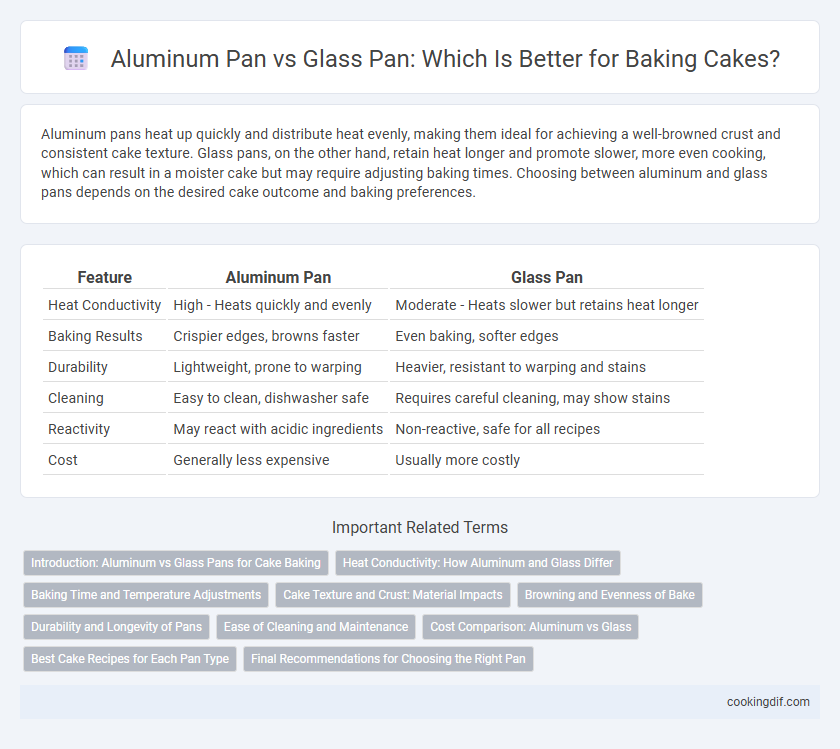Aluminum pans heat up quickly and distribute heat evenly, making them ideal for achieving a well-browned crust and consistent cake texture. Glass pans, on the other hand, retain heat longer and promote slower, more even cooking, which can result in a moister cake but may require adjusting baking times. Choosing between aluminum and glass pans depends on the desired cake outcome and baking preferences.
Table of Comparison
| Feature | Aluminum Pan | Glass Pan |
|---|---|---|
| Heat Conductivity | High - Heats quickly and evenly | Moderate - Heats slower but retains heat longer |
| Baking Results | Crispier edges, browns faster | Even baking, softer edges |
| Durability | Lightweight, prone to warping | Heavier, resistant to warping and stains |
| Cleaning | Easy to clean, dishwasher safe | Requires careful cleaning, may show stains |
| Reactivity | May react with acidic ingredients | Non-reactive, safe for all recipes |
| Cost | Generally less expensive | Usually more costly |
Introduction: Aluminum vs Glass Pans for Cake Baking
Aluminum pans heat up quickly and provide even heat distribution, resulting in consistent cake browning and texture. Glass pans heat more slowly but retain heat longer, which can lead to longer baking times and potentially drier edges. Choosing between aluminum and glass pans depends on the specific cake recipe and desired baking characteristics.
Heat Conductivity: How Aluminum and Glass Differ
Aluminum pans offer superior heat conductivity, allowing cakes to bake evenly and brown consistently due to their rapid and uniform heat distribution. Glass pans heat more slowly and retain heat longer, which can cause cakes to cook unevenly or overbake at the edges. Understanding the thermal properties of aluminum versus glass helps bakers choose the optimal pan for precise temperature control and desired cake texture.
Baking Time and Temperature Adjustments
Aluminum pans conduct heat more efficiently than glass pans, resulting in shorter baking times and generally requiring temperatures to be lowered by 25degF to prevent overbaking. Glass pans heat more slowly and retain heat longer, often necessitating an increase in baking time by 5 to 10 minutes and maintaining the original recipe temperature. Adjusting baking time and temperature according to the pan material ensures even cooking and optimal cake texture.
Cake Texture and Crust: Material Impacts
Aluminum pans conduct heat quickly and evenly, promoting a moist, tender cake texture with a lightly browned crust. Glass pans heat more slowly but retain heat longer, often resulting in a denser crumb and a thicker, darker crust. Choosing between aluminum and glass pans directly influences the cake's internal softness and crust development due to their distinct thermal properties.
Browning and Evenness of Bake
Aluminum pans excel in heat conduction, promoting superior browning and an evenly baked cake crust due to their rapid, consistent heat distribution. Glass pans heat more slowly and retain heat longer, which can cause cakes to brown less intensely and bake unevenly, especially at the edges. For optimal browning and uniform cake texture, aluminum pans are typically preferred over glass.
Durability and Longevity of Pans
Aluminum pans offer excellent durability due to their resistance to warping and ability to withstand high temperatures without damage, making them a long-lasting choice for frequent cake baking. Glass pans, while durable in terms of scratch resistance, are more prone to cracking or shattering under sudden temperature changes, which can reduce their lifespan. Choosing an aluminum pan can provide superior longevity and consistent baking performance, especially for avid bakers seeking reliable kitchen tools.
Ease of Cleaning and Maintenance
Aluminum pans offer a smooth surface that resists sticking and typically requires minimal scrubbing, making them easier to clean after baking. Glass pans, while heavier and more fragile, provide a non-porous surface that generally holds up well in the dishwasher but may require soaking to remove baked-on residue. Choosing between aluminum and glass pans depends on the preferred cleaning method and willingness to maintain the pan's finish over time.
Cost Comparison: Aluminum vs Glass
Aluminum pans generally cost less than glass pans, making them a budget-friendly choice for bakers. Aluminum's lightweight and inexpensive manufacturing contribute to its lower price, while glass pans are pricier due to heavier material and heat resistance properties. Investing in aluminum pans offers affordability without sacrificing performance, whereas glass pans may require higher upfront costs but provide even heat distribution.
Best Cake Recipes for Each Pan Type
Aluminum pans excel in even heat conduction, making them ideal for dense, moist cakes like pound cakes and brownies that require consistent baking temperatures. Glass pans retain heat longer, which suits recipes such as layered or fruitcakes where gradual cooking helps develop flavors and prevent overbaking. Choosing the right pan based on material enhances the texture and outcome of specific cake recipes.
Final Recommendations for Choosing the Right Pan
Aluminum pans provide superior heat conduction, resulting in evenly baked cakes with crisp edges, ideal for recipes requiring precise temperature control. Glass pans heat more slowly and retain heat longer, producing cakes with a moister texture and golden-brown crust, best suited for slow baking methods. Choose aluminum for quick, consistent baking and glass when a gentler, longer bake is preferred to enhance moisture and tenderness.
Aluminum Pan vs Glass Pan for cake baking Infographic

 cookingdif.com
cookingdif.com